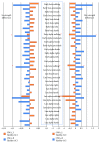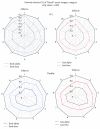Functional Brain Connectivity during Multiple Motor Imagery Tasks in Spinal Cord Injury
- PMID: 29853852
- PMCID: PMC5954936
- DOI: 10.1155/2018/9354207
Functional Brain Connectivity during Multiple Motor Imagery Tasks in Spinal Cord Injury
Abstract
Reciprocal communication of the central and peripheral nervous systems is compromised during spinal cord injury due to neurotrauma of ascending and descending pathways. Changes in brain organization after spinal cord injury have been associated with differences in prognosis. Changes in functional connectivity may also serve as injury biomarkers. Most studies on functional connectivity have focused on chronic complete injury or resting-state condition. In our study, ten right-handed patients with incomplete spinal cord injury and ten age- and gender-matched healthy controls performed multiple visual motor imagery tasks of upper extremities and walking under high-resolution electroencephalography recording. Directed transfer function was used to study connectivity at the cortical source space between sensorimotor nodes. Chronic disruption of reciprocal communication in incomplete injury could result in permanent significant decrease of connectivity in a subset of the sensorimotor network, regardless of positive or negative neurological outcome. Cingulate motor areas consistently contributed the larger outflow (right) and received the higher inflow (left) among all nodes, across all motor imagery categories, in both groups. Injured subjects had higher outflow from left cingulate than healthy subjects and higher inflow in right cingulate than healthy subjects. Alpha networks were less dense, showing less integration and more segregation than beta networks. Spinal cord injury patients showed signs of increased local processing as adaptive mechanism. This trial is registered with NCT02443558.
Figures








References
Publication types
MeSH terms
Associated data
LinkOut - more resources
Full Text Sources
Other Literature Sources
Medical

